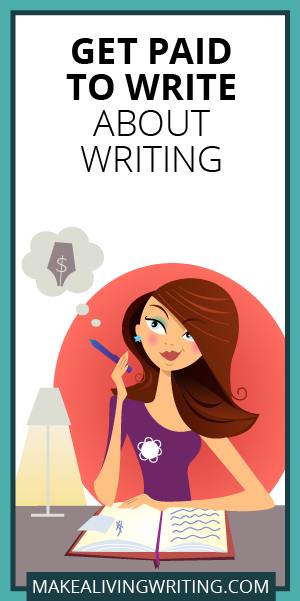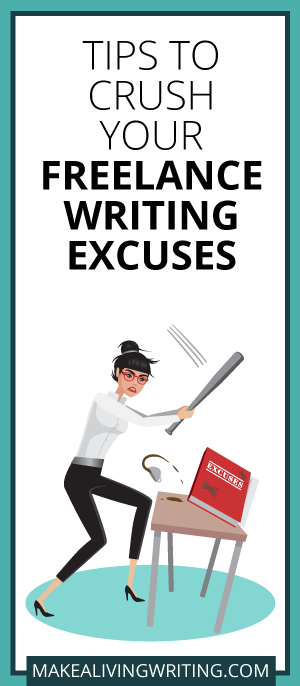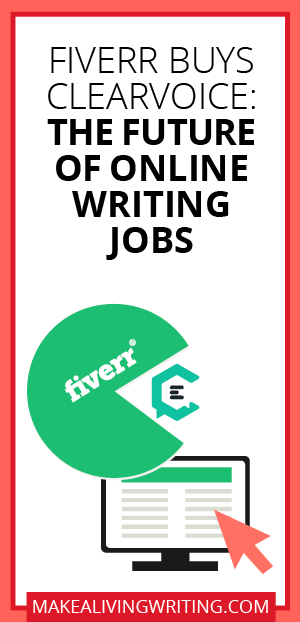 Want to get paid to write about writing? If you know a little something about the business and craft of freelancing, you can cash in on your ideas and experience.
Want to get paid to write about writing? If you know a little something about the business and craft of freelancing, you can cash in on your ideas and experience.
Here’s what I’m talking about:
It’s no secret that finding a niche is a smart strategy to grow your freelance writing business. Everyone should have a niche, or two or three. And writing can be one of them.
In fact, there’s a number of online and print markets that serve freelance writers and some pay up to $1,500 per assignment. Pitch these places great story ideas, and you can get paid to write about things like:
- How to write great headlines
- Interview tricks to get sources to spill the beans
- Profiles about thought leaders, authors, or pros in writing and publishing
- Query letter strategies to land assignments
- Business tips to be a successful freelancer
Want to get paid to write about writing? Check out these markets that cover the business and craft of freelance writing, and start pitching.
Got some insight about how to to be a better writer, develop story ideas, or make a good first impression at a writer’s conference? You can turn those ideas into an assignment for Author, the magazine for the Pacific Northwest Writers Association.
The how-to of freelance writing is the staple of this niche magazine. But Editor Bill Kenower says, he’s also interested in stories and essays about the hustle of freelancing, dealing with rejection, working in isolation, and tips to stay motivated.
Contact: Editor Bill Kenower
Rates: Depends on assignment
If you’ve followed the field of journalism for any period of time, you’ve probably heard of Columbia Journalism Review. It’s a product of the Columbia University Graduate School of Journalism on the state of journalism that’s been published for nearly 60 years.
And it’s just as current now as it was when it started. Just check out a couple of recent headlines: “It’s time to rethink coverage of school shootings,” and “How YouTube reactionaries are breaking news media.”
Have a story idea, insight, or perspective on news about the news? This is one of the highest-paying magazines in the journalism niche, especially since the demise of its rival American Journalism Review.
Contact: Managing Editor Betsy Moralis
Rates: $0.50 to $1 per word, based on assignment
If you’re a business trying to build a blog, an entrepreneur generating content to grow a business, or a marketing director trying to capture a piece of your market, or a freelance writer, content is king. And it’s what Craft Your Content specializes in.
This site is dedicated to helping writers get better at the craft, develop voice and style, and build a freelance business, says Director of Content Erika Rasso. Your best to land an assignment: Pitch stories ideas about grammar, business, tips to boost creativity, and productivity habits for freelance writers.
Contact: Director of Content Erika Rasso
Rates: $75 to $100 per assignment
Be a Freelance Blogger founder Sophie Lizard recently told us: “If you can find work at $10 or $20 per post, then you can find it at $100 per post. It’s all a matter of marketing and negotiation. For the love of all that’s holy, build your business skills so that you can charge what you’re worth.”
Strike a nerve with you? If you’ve got an idea for a blog post about freelance writing, making money, raising your rates, or some other idea to help freelance writers crush it, pitch Sophie your idea.
Contact: Sophie Lizard
Rates: $100 per post
You don’t have to look far to know digital content is everywhere. Your inbox, smartphone, social media, the Interwebs. When you understand how to write great content in a digital world, you’re a little closer to unlocking the mysteries of SEO and Google rankings. That’s the kind of content EContent features in its magazine to help writers and marketing professionals.
Want to write for this trade pub? Check out the guidelines, read back issues, and download the 2019 editorial calendar. Then pitch Editor Theresa Cramer.
Contact: Editor Theresa Cramer
Rates: Based on assignment
Freedom with Writing Editor Jacob Jans says his company’s primary goal is helping freelancers make money writing. It’s why lists of markets, job leads, and writing gigs are a big part of the Freedom with Writing website.
But Jans says, his site also serves as a resource to help writers develop skills to write better, be more productive, charge higher rates, and find better-paying clients. And you’ll find similar advice in his book:
Have blog post or article idea to help freelancers earn more money and more freedom? Pitch your idea to Jans. Best way to break in: Pitch a case study about how you landed an assignment that other writers can replicate.
Contact: Editor Jacob Jans
Rates: $30 to $500, based on assignment
If you’ve ever struggled with self-doubt about earning a living as a freelance writer, you’re not alone. But it’s possible to make a living writing as a part-time gig or a full-time endeavor, says Funds for Writer Founder C. Hope Clark. And sometimes it takes more than pitching or a lucky break.
She recently told Make a Living Writing: “It takes guts and diligence for a freelancer to rise above the change and outlast that flighty influx of competition. Word-of-mouth leads the pack in finding work. Most clients rely heavily on the recommendation of a peer.”
Networking. It’s one strategy that can help you move up and earn more as a freelance writer. And it’s what Clark teaches writers how to do on her blog, with the help of guest post writers like you.
She’s looking for guest posts about things like breaking into new markets, success stories, tips for pitching seasonal stories, grant and non-profit writing, and more.
Rates: $50 per assignment
Contact: C. Hope Clark
When freelance writer Dana K. Cassell founded the Writers-Editors Network almost 40 years ago, she never imagined reaching a global audience of freelance writers, authors, and marketing professionals. But that’s what happened.
Cassell publishes the Freelance Writer’s Report for an experienced audience of freelance writers who want to stay current on trends, strategies, and opportunities in publishing and writing.
“Many of them have published hundreds of magazine articles, several books, or worked for dozens of business clients,” says Cassell. “We are interested only in information these writers can learn from and put to immediate use.”
Rates: $0.10 per word, based on assignment
Contact: Dana K. Cassell
Carol Tice launched Make a Living Writing a decade ago to help writers do just that. About 1,000 blog posts later, she’s a recognized expert in the freelance niche who’s helped thousands of writers move up and earn more.
Got a guest post idea about the business and craft of freelance writing? Developed a strategy to land high-paying clients? Or finally crawled out of a hole to face your fears, market your business and get freelance writing clients?
Study the site. Read past blog posts. And get familiar with the guidelines. Then pitch your idea to Editor Evan Jensen.
Contact: Editor Evan Jensen
Rates: $75 to $150, based on assignment
Quill is a trade magazine about journalism published by the Society of Professional Journalists. It’s another voice among just a handful of pubs (like Columbia Journalism Review) that publish content about the state of journalism, what it’s like to work in the business, and how to navigate the ever-changing landscape from the print-era to 24/7 digital journalism.
Need some inspiration to pitch a story idea to Quill? Just check out some of these recent headlines: “Edit like a boss: Cool tools to help you master the trade,” and “Local news deserts evolving into oases for entrepreneurs.”
Contact: Editor Monica Williams
Rates: Depends on assignment
Your best way to break in at Women on Writing? Pitch an idea for a how-to article on a writing or publishing topic, says founder and CEO Angela Mackintosh. Bonus if you can reach out and interview experts like authors, literary agents, and publishers.
Contact: Founder Angela Mackintosh
Rates: Pays $50-$150, based on assignment
If you want to land an assignment with The Writer, study the magazine. There’s eight departments that feature stories about the business and craft of freelance writing (this mag happens to cover magazine writing and copywriting, as well as fiction and non-fiction book writing).
“We’re interested in query letters on concrete topics written by emerging and experienced writers in all genres,” says Senior Editor Niki Porter. “We are looking for clear takeaway for our readers: What can they learn to improve their writing or advance their careers? What how-to tips and strategies will accomplish this?
Contact: Senior Editor Niki Porter
Rates: Depends on assignment
Want to get into the head-space of newly appointed Writer’s Digest Editor-in-Chief Erika McIntyre to improve your chances of landing an assignment with this niche magazine for freelance writers? Take a few minutes to listen the the Jan. 3, 2019 Writer’s Digest podcast.
The short version: “I don’t plan to fix anything here that isn’t broken,” says McIntyre. “But I will not be exactly like any previous editor—I’ll be me… I’ll also be seeking out new voices in the publishing world, to bring more diversity and new ways of thinking about writing here.”
And that’s a good thing, if you’re interested in writing about the business and craft of freelance writing for Writer’s Digest. Before you pitch, study the magazine, guidelines, and take a look at the 2019 editorial calendar.
Contact: Editor-in-Chief Erika McIntyre
Rate: $750 to $1,500, based on assignment
Writer’s Weekly publishes articles about making money from writing, publishing, avoiding scams, marketing, motivation, and the business of freelancing. Best way to break in: Get familiar with the site and the Writer’s Weekly audience, and study the guidelines, says Editor Angela Hoy.
And if you need a laugh, or want to compare your query letter to some of the worst, check out this recent post at Writer’s Weekly: World’s Worst Query Letters or Book Proposals for February 2019.
Contact: Editor Angela Hoy
Rates: $40 to $60, based on assignment
Here’s another niche trade magazine for freelance writers. Written By is published by the Writers Guild of America, and caters to both fiction and non-fiction writers.
Last month long-time Written By editor Richard Stayton stepped down after a successful 20-year run at the magazine. “No one is pushing me out the door,” Stayton wrote in an editorial. “But I sense that this is the right time for my decision.”
Written By publishes stories about the business and craft of screenwriting and freelance life and opportunities for writers in the entertainment industry. Check Writer’s Market for more info, and check back at Written By for news about the new editor.
Contact: Written By editorial office
Rates: $1,500 and up, based on assignment
Get paid to write about writing
Maybe you’re not ready to make “writing” your one and only niche. And that’s just fine. But if you’ve been in the trenches hustling work, pitching editors, interviewing sources, and learning how to run a freelance business, why not turn some of that experience into a story idea and get paid? Take a look at this list of markets to get paid to write about writing, and get started.
Want to get paid to write about writing? Let’s discuss in the comments.
Evan Jensen is the blog editor for Make a Living Writing. When he’s not on a writing deadline or catching up on emails, he’s training to run another 100-mile ultra-marathon.

The post Get Paid to Write About Writing: 15 Markets That Pay Up to $1,500+ appeared first on Make A Living Writing.
from Make A Living Writing http://bit.ly/2XdSvsi
 Photo by Renee Verberne on Unsplash
Photo by Renee Verberne on Unsplash Want to write a guest post for Make a Living Writing?
Want to write a guest post for Make a Living Writing?
 Photo by
Photo by  Photo by
Photo by 









 Ever wonder if there’s a superpower to help you find great writing jobs?
Ever wonder if there’s a superpower to help you find great writing jobs? It’s the middle of the afternoon. You’ve got a client deadline. And all you’ve been able to do for the last few hours is think up writing excuses for why you’re not cranking out copy.
It’s the middle of the afternoon. You’ve got a client deadline. And all you’ve been able to do for the last few hours is think up writing excuses for why you’re not cranking out copy.
 Say you’ve got an idea for a magazine article. You write up a query and send it in.
Say you’ve got an idea for a magazine article. You write up a query and send it in. Photo by
Photo by 









 Want to get paid to write about writing? If you know a little something about the business and craft of freelancing, you can cash in on your ideas and experience.
Want to get paid to write about writing? If you know a little something about the business and craft of freelancing, you can cash in on your ideas and experience. If you missed the news this week, there was a major development in the world of online writing jobs. Better-paying, fixed-rate writer platform
If you missed the news this week, there was a major development in the world of online writing jobs. Better-paying, fixed-rate writer platform